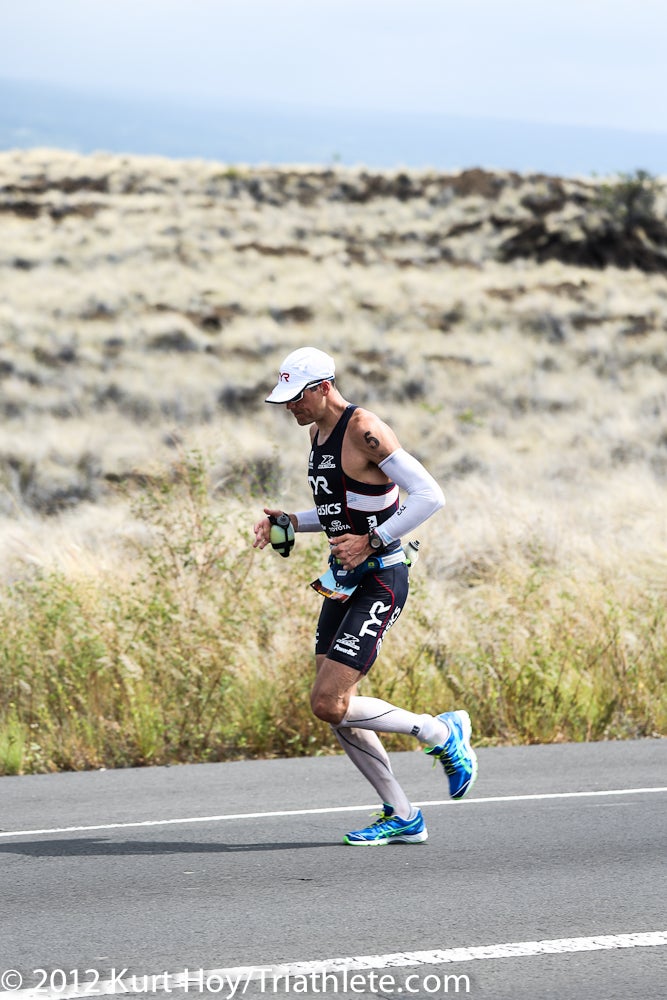How Compression Apparel Works

Andy Potts races in compression socks. Photo: Kurt Hoy
What’s with all the spandex?
You’ve probably seen fellow racers wearing tall compression socks, calf sleeves, thigh highs and full tights, wondered what they’re all about and whether you should get some, too. These garments are based on a concept medicine validated long ago: that compression clothing increases blood and lymphatic flow. In sports, compression garments are meant to improve performance and expedite recovery. Although there isn’t yet a consensus among experts if compression apparel really works, research has shown that it just might do what manufacturers say it does.
Running Performance
How it works: Squeezing blood vessels causes them to open forcefully, which allows more blood and oxygen into the compressed muscle and helps shunt waste. This in-with-the-good-out-with-the-bad increases the working muscles’ capacity to produce energy and allows the wearer to run faster.
Does it really happen?
Research conducted by the University of Newcastle found that lower body compression garments increase blood flow and reduce heart rate during high-intensity endurance running, supporting the theory that compression socks should improve performance. But that same study didn’t find that compression clothing actually made runners faster. And other researchers have also found that compression socks don’t improve 10K running performance. Three things could cause this contradiction: The original finding could be wrong, the runners’ performance might be improved by an amount too small for the study to find significant or the weight of the socks could counteract their physiological benefit. It sounds crazy, but carrying the socks—they weigh roughly three ounces—hampers performance. For some perspective, three ounces is the same weight difference between Asics’ supportive, gel-cushioned Kayano trainers and their lightweight road-racing shoe, the Speedstar. Three ounces is not trivial.
RELATED – Under Pressure: Does Compression Apparel Work?
Reduced Soreness
How it works: The foot striking the ground sends vibration up the runner’s leg and causes muscles to shake. This is thought to damage muscles and add to post-exercise soreness. Compression apparel secures the muscles in place to prevent muscular breakdown.
Does it really happen?
Research conducted by Massey University in Auckland found that there was a reduction in delayed-onset muscle soreness 24 hours after exercise when wearing graduated compression stockings after a fast-paced 10K road run. Interestingly, this study found that soreness was reduced specifically in the compressed muscle region. Ninety-three percent of subjects who ran without compression socks experienced lower leg soreness a day after the run, but only 14 percent of the subjects who ran with the socks had similar soreness.
RELATED – Triathlete Buyer’s Guide: Compression
Expedited Recovery
How it works: By creating extra blood flow, wearing compression after exercise is purported to expedite the removal of metabolic waste and re-introduce the substances muscles require to rebuild.
Does it really happen?
There is some research to support countless anecdotes from athletes and air travelers who claim their legs feel fresher after wearing compression. Scientists at the University of Exeter measured recovery with three strength exercises conducted one, two, three and four days after soreness-inducing plyometric exercise. They found that wearing compression for 24 hours following exercise improved performance in all three strength tests and reduced the soreness perceived by the subjects.
RELATED: Do Compression Socks Really Work?
Who Makes Compression Apparel?
2XU • www.2xuusa.com
CEP • www.cepcompression.com
CW-X • www.cw-x.com
Skins • www.skins.net
SL3S • www.slstri.com
Injinji • www.injinji.com
Zoot • www.zootsports.com